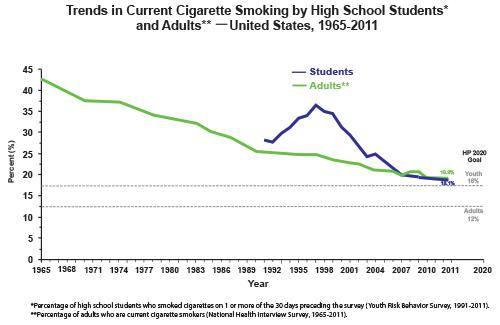
Source: Flickr user Morgan.
Times are changing in the tobacco industry whether cigarette producers and consumers are ready for it or not.
Earlier this decade a pledge was enacted by the federal government to cut the number of adult smokers by 2020 to 12% or less of the population. The Healthy People 2020 initiative, as it's known, is founded on educating the public about the dangers of smoking, providing assistance with quitting, and running aggressive advertisement campaigns across multiple media channels highlighting the damaging effects of smoking. It's also concurrently backed up by tobacco producers' need to raise cigarette prices as demand for tobacco products falls. Higher pricing acts as a potential detriment to current smokers.
Altogether, these tactics helped cigarette smoking hit another important milestone in 2013 based on the latest data from the Morbidity and Mortality Weekly Report, or MMWR.
Tobacco's big milestone
According to the Centers for Disease Control and Prevention, which used data from the National Health Interview Survey in 2013, there are now just 42.1 million smokers aged 18 and up (17.8% of the population) compared to 45.1 million adult smokers (20.9% of the population) in 2005. That 3 million smoker reduction is a strong step in the right direction, and an all-time record low among adult smokers. For added context, smoking rates among adults 50 years ago were about 42%!

Source: Centers for Disease Control and Prevention.
Additionally, even those people who are still smoking are smoking less per day. The survey showed the average number of cigarettes smoked per day fell from 16.7 in 2005 to 14.2 in 2013. This was especially noticeable among heavy smokers where those who smoke 30 or more cigarettes per day made up just 7.1% of all smoking adults compared to 12.7% in 2015. Respondents that smoked 20-29 cigarettes per day also saw a noticeable decline from 34.9% of all smokers in 2005 to just 29.3% in 2013.
The fight against tobacco is certainly not something everyone is going to agree with (there are still 42 million-plus smokers out there), but its negative effects on the body are without argument. Smoking has been linked to heart disease and lung cancer, two of the more prevalent killers in the U.S., and it takes an incredible toll on the healthcare system, costing $289 billion annually in combined direct healthcare expenses and indirect productivity losses. Not to mention, tobacco use kills 480,000 people prematurely each year. It's no wonder the CDC refers to tobacco as the leading cause of preventable disease and death in the United States.
Alternatives exist, but may not be ideal
Alternatives to cigarettes do exist, but not all of them may prove ideal. In addition to nicotine patches and gum, it's possible that electronic cigarettes may also play a role in reducing tobacco consumption, though that assumption is up for some argument.

Source: Flickr user Joseph Morris.
The premise behind the electronic cigarette is simple. A liquid containing nicotine is vaporized within a cartridge that may or may not resemble a cigarette and inhaled as if the user were smoking a cigarette. The device allows a user to get their nicotine without the many other carcinogenic products typically associated with traditional cigarette smoke. Blu, which is the market-leading electronic cigarette brand with about half of all electronic cigarette sales, is owned by Lorillard (LO +0.00%) in the meantime, but the pending purchase of Lorillard by Reynolds American (RAI +0.00%) will see the Blu brand eventually divested.
However, the CDC has shed plenty of question marks on the electronic cigarette sector, too. A CDC study from September showed that while electronic cigarette usage grew from 3% of the population to 8% between 2010 and 2012, it remained flat at 8% in 2013. Furthermore, just 2% of the population used an electronic cigarette within the past 30 days. In other words, electronic cigarettes rapid growth may have already come and gone.
Concerns also exist about the true intentions of electronic cigarette producers. With flavored liquid vapor that would appear to appeal to a younger audience, and no direct evidence that it's helping people put their tobacco products down, it's likely that traditional quitting methods proposed for decades by the CDC will remain the primary method of getting current smokers to not light up.
An interesting winner
Because cigarettes are so addictive the strong pricing power of tobacco producers all but assures their cash flow will still remain strong, even if there are minimal declines on an annual basis in terms of volume. But, tobacco producers aren't who I believe this latest report benefits most. Instead, I consider the MMWR a continuing victory for the nation's insurers.

Source: Official U.S. Navy Page via Flickr.
On the surface the logic behind my assumption might seem flawed. Under the Affordable Care Act, or Obamacare as you might know it best, people are required by the individual mandate to purchase health insurance or face a penalty. Part of the new requirements built into Obamacare also state that insurers can't deny coverage to people based on preexisting conditions. Among the very few options insurers still have of charging one consumer more than the next is whether or not they use tobacco products. Tobacco users can wind up paying 50% higher premium costs than non-tobacco users.
The implication here might be "Great! Insurers are getting more money upfront because of smokers!" The problem is that smoking can cause serious lifelong complications that can get extremely pricey for insurers and are unlikely to be made up by a 50% increase in monthly premiums. A steady reduction in smoking rates means national insurers like UnitedHealth Group (UNH +0.98%) are likely to see a reduction in smoking-related chronic illnesses from their members, which helps save them money in the long run.
One final note, let's not also overlook that the American public is a winner here too. A reduction in first-hand and second-hand smoking may lead to reduced incidence rates of lung cancer, heart disease, and a handful of other ailments over time. This means people could lead longer, healthier lives.






